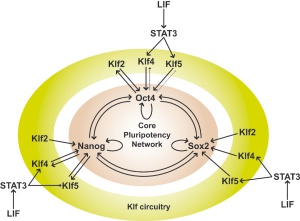Embryology History - Shinya Yamanaka: Difference between revisions
| Line 26: | Line 26: | ||
* '''1999''' - Associate professor at the Nara Institute of Science and Technology. | * '''1999''' - Associate professor at the Nara Institute of Science and Technology. | ||
* '''2004''' - Professor at Kyoto University. | * '''2004''' - Professor at Kyoto University. | ||
* '''2010''' - [http://emuseum.kyotoprize.org/en/ShinyaYamanaka Kyoto Prize in Advanced Technology] | [http://emuseum.kyotoprize.org/sites/default/files/26kA_e.pdf Lecture text PDF] | |||
==Key Paper== | ==Key Paper== | ||
Revision as of 10:07, 9 October 2012
Introduction
Draft Page
- Links: Induced Stem Cells | Stem Cells
Some Recent Findings
|
The Nobel Prize in Physiology or Medicine 2012 was awarded jointly to Sir John B. Gurdon and Shinya Yamanaka
|
Recent References | References
Research History
- 1987 - M.D. at Kobe University, worked as a resident in orthopedic surgery at National Osaka Hospital for two years.
- 1993 - Ph.D. in medicine at Osaka City University and moved to the United States as a postdoctoral fellow at the Gladstone Institute of Cardiovascular Disease, in San Francisco, CA.
- 1996 - Assistant professor at Osaka City University School of Medicine.
- 1999 - Associate professor at the Nara Institute of Science and Technology.
- 2004 - Professor at Kyoto University.
- 2010 - Kyoto Prize in Advanced Technology | Lecture text PDF
Key Paper
Induction of pluripotent stem cells from mouse embryonic and adult fibroblast cultures by defined factors
Cell. 2006 Aug 25;126(4):663-76. Epub 2006 Aug 10.[1]
Takahashi K, Yamanaka S.
Source
Department of Stem Cell Biology, Institute for Frontier Medical Sciences, Kyoto University, Kyoto 606-8507, Japan.
Abstract
Differentiated cells can be reprogrammed to an embryonic-like state by transfer of nuclear contents into oocytes or by fusion with embryonic stem (ES) cells. Little is known about factors that induce this reprogramming. Here, we demonstrate induction of pluripotent stem cells from mouse embryonic or adult fibroblasts by introducing four factors, Oct3/4, Sox2, c-Myc, and Klf4, under ES cell culture conditions. Unexpectedly, Nanog was dispensable. These cells, which we designated iPS (induced pluripotent stem) cells, exhibit the morphology and growth properties of ES cells and express ES cell marker genes. Subcutaneous transplantation of iPS cells into nude mice resulted in tumors containing a variety of tissues from all three germ layers. Following injection into blastocysts, iPS cells contributed to mouse embryonic development. These data demonstrate that pluripotent stem cells can be directly generated from fibroblast cultures by the addition of only a few defined factors.
Comment in
Yamanaka Factors
Yamanaka Factors[4][5] Are a set of 4 transcription factors when introduced into cells induces stem cell formation. These four transcription factors can be expressed from doxycycline (dox)-inducible lentiviral vectors.
OCT4
- Transcription factors containing the POU homeodomain
- Links: OMIM - OCT4
SOX2
- Sry-related HMG-Box gene 2
- Links: OMIM - SOX2
KLF4
- Kruppel-like factor 4, zinc finger protein, transcription factor which acts as both an activator and repressor.
- Links: OMIM - KLF4
cMyc
- The MYC protooncogene encodes a DNA-binding factor that can activate and repress transcription.
- Ectopic expression of c-Myc can also cause tumorigenicity in offspring.
- Links: OMIM - MYC
- More recently shown that Oct4 together with either Klf4 or c-Myc is sufficient to generate iPS cells from neural stem cells.[6]
- Tbx3 transcription factor significantly improves the quality of iPS cells.[7]
References
Reviews
<pubmed></pubmed> <pubmed></pubmed> <pubmed></pubmed>
Articles
<pubmed>20535199</pubmed> <pubmed>18035408</pubmed> <pubmed>16904174</pubmed>
Journal of Visualized Experiments - Generating iPS Cells from MEFS through Forced Expression of Sox-2, Oct-4, c-Myc, and Klf4
Search PubMed
Search PubMed Now: ** Yamanaka+S | induced pluripotent stem cell |
External Links
External Links Notice - The dynamic nature of the internet may mean that some of these listed links may no longer function. If the link no longer works search the web with the link text or name. Links to any external commercial sites are provided for information purposes only and should never be considered an endorsement. UNSW Embryology is provided as an educational resource with no clinical information or commercial affiliation.
- 2010 Kyoto Prize Laureate in Advanced Technology | Commemorative Lecture text PDF
- 2009 ScienceWatch interview
Glossary Links
- Glossary: A | B | C | D | E | F | G | H | I | J | K | L | M | N | O | P | Q | R | S | T | U | V | W | X | Y | Z | Numbers | Symbols | Term Link
Cite this page: Hill, M.A. (2024, April 18) Embryology Embryology History - Shinya Yamanaka. Retrieved from https://embryology.med.unsw.edu.au/embryology/index.php/Embryology_History_-_Shinya_Yamanaka
- © Dr Mark Hill 2024, UNSW Embryology ISBN: 978 0 7334 2609 4 - UNSW CRICOS Provider Code No. 00098G
